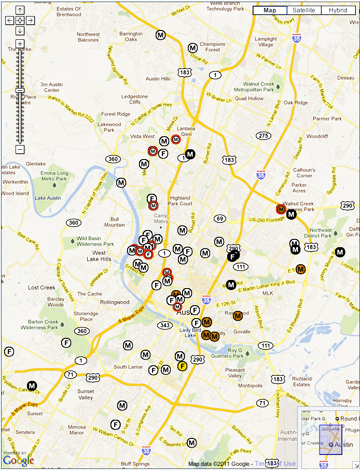Investigative Report
Austin city manager finalist Platt drops out
Six council members and numerous lobbyists appear to have criminally violated city’s lobby law
Austin-Bergstrom International Airport sets records but CEO is out
City Manager Faces Crucial Annual Review
Texas Earns a Poor Grade for Integrity
Here’s How the Mayor and Council Spent
Appraisal Records Hidden From Public View
At-Large Elections Favor Anglo Choices
Forty Years of Election History
Expose Extent of Disparities
by Ken Martin
© The Austin Bulldog 2011
It should come as no surprise that the greatest political power is exercised by those whose wealth, influence, and avid participation enable them to move the levers of democracy in their favor.
 The extent to which this is true in Austin is laid bare by maps constructed by The Austin Bulldog that pinpoint the residential location of every mayor and council member elected over the last four decades.
The extent to which this is true in Austin is laid bare by maps constructed by The Austin Bulldog that pinpoint the residential location of every mayor and council member elected over the last four decades.
The unalterable fact that emerges is that large parts of Austin are not represented—or are grossly underrepresented—because of the at-large system of elections established by the Austin City Charter.
This is not a new revelation. Attempts to gain voter approval for some form of council districts that would provide for equitable geographic representation have been put on the ballot six times, beginning in 1973, and six times failed to win majority support.
The ship of democracy continues to sail in the direction ordered by the majority. Which is how democracy is supposed to work.
But at what cost to those who feel disenfranchised by Austin’s at-large election system? The at-large system effectively means that all citizens—all 800,000 of us—are represented by every member of the city council. This system fails to make any one council member responsible for our concerns, or those of our neighbors. When every council member is responsible to every citizen, by definition, no one council member is responsible to a particular citizen.
The Austin City Council and a growing coalition of citizens are separately working on two different plans to give voters another opportunity in 2012 to approve a City Charter change to require the majority of city council members to be elected from geographic districts.
Based on what’s been discussed so far, these two initiatives differ significantly regarding how many council districts would be proposed, what procedure would be used for drawing district lines, the length of council terms, and whether terms would be staggered.
Both initiatives are still in the formative stages.
The City Council is scheduled to approve a resolution today (Item 28 on the agenda) to establish a 2012 Charter Revision Committee composed of 15 members who shall be appointed no later than August 25. The committee’s recommendations for charter amendments, and a map that includes any combination of at-large and geographic representation, are due by January 31.
The city’s plan or the grass-roots plan, or both, could wind up on the ballot next year.
But it should be noted that this appears to be the first time that a broad coalition of community organizations have launched a serious effort to formulate a plan that is independent of whatever proposal the city council puts forward, according to those involved in previous election campaigns for council districts.
None of the six failed propositions got on the ballot through a grass-roots petition drive. In the past, voters have only been able to react to whatever plan the city proposed—and the reaction has always been unfavorable.
Why geographic representation?







